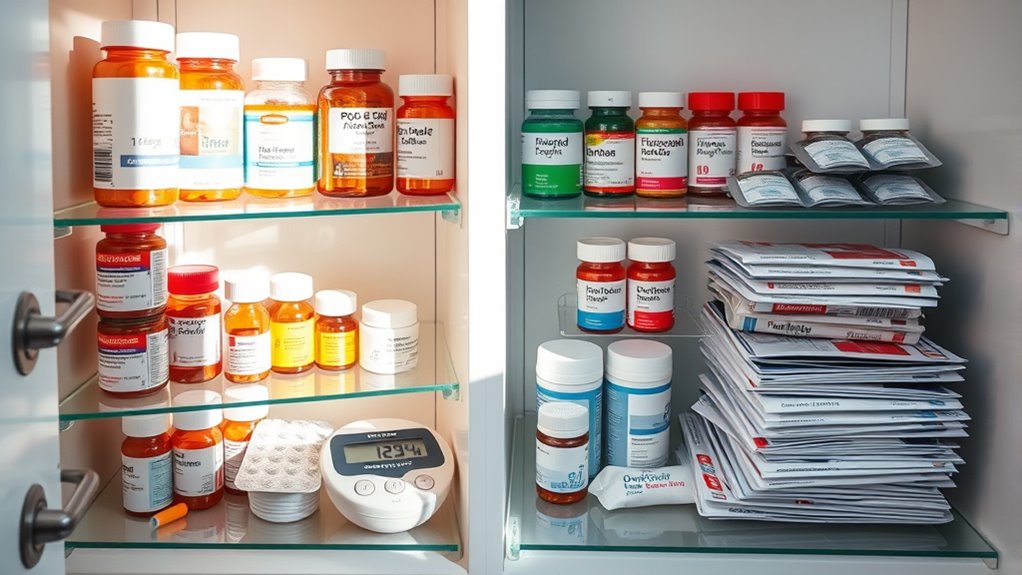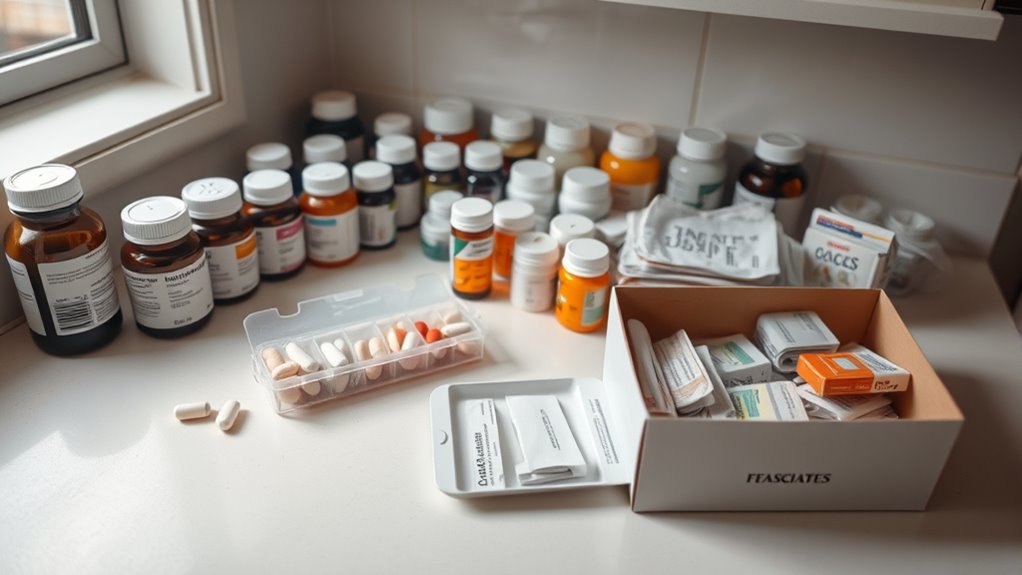To organize medications and supplies at home, choose a central, secure spot like a kitchen or bathroom cabinet. Use clear or labeled containers and keep everything together, including prescriptions, OTC meds, and first aid items. Store medicines in their original containers and regularly check for expiration. Keep frequently used items accessible. Maintaining a tidy, labeled space not only improves safety but also makes it easier to find what you need quickly. Discover more tips to perfect your home organization.
Key Takeaways
- Select a central, secure, and accessible storage area like a labeled cabinet or drawer.
- Categorize supplies into prescriptions, OTC, first aid, vitamins, and specialty items for easy retrieval.
- Use clear containers and labels to improve visibility and prevent medication errors.
- Keep medications in original containers with labels; store supplies in portable kits for safety.
- Regularly review inventory, check expiration dates, and maintain cleanliness to ensure safety and order.

Keeping medications and supplies organized at home is crucial for safety and quick access. When your medications are properly arranged, you reduce the risk of accidental misuse, ensure you take the right dose at the right time, and prevent expired products from cluttering your space. To achieve this, focus on medication safety by implementing effective supply storage tips that keep everything visible, reachable, and secure. First, designate a specific storage area for all your medications and supplies. A cabinet or drawer in a central location, like the kitchen or bathroom, works well. Just make sure it’s out of reach of children and pets. Use clear containers or labeled bins so you can easily identify items without rummaging through multiple boxes. This not only promotes safety but also saves time when you need something quickly.
Next, organize your supplies by category—prescriptions, over-the-counter medicines, first aid items, vitamins, and specialty products. Keep frequently used medications at the front or on top, so you don’t have to dig through everything every time. Incorporate small dividers or drawer organizers to separate different items, preventing clutter from building up and making it easier to locate what you need. For medicines, always check expiration dates regularly and discard expired products safely. Consider using a medication management app or a simple chart to keep track of when you last took each dose, which helps prevent missed doses or double dosing. Additionally, understanding the importance of space optimization can help you effectively utilize your storage areas and prevent clutter from accumulating. Properly labeled and organized storage can also aid in medication safety, reducing errors and enhancing overall home safety.
Furthermore, investing in storage solutions designed specifically for small spaces can maximize your available area and keep everything orderly. When storing medications, think about incorporating visibility, so you can quickly see what’s inside without opening multiple containers, further enhancing safety and efficiency. In addition, store medications in their original containers whenever possible. The labels contain essential information like dosage instructions, expiration dates, and safety warnings. Avoid transferring medications into unmarked containers, as this can lead to misuse or confusion. For supplies like bandages, antiseptics, or thermometers, keep them in a separate, portable kit or container. This makes it easier to grab everything you need in an emergency and prevents small items from getting lost or mixed up.
Finally, maintain your organization by routinely reviewing your supplies and cleaning the storage area. Regularly checking your inventory helps prevent medication expiration and ensures you have necessary supplies on hand. Replace expired items, restock essentials, and tidy up to prevent dust and dirt. Establishing and maintaining these supply storage tips ensures your medications and supplies stay safe, accessible, and well-maintained. Proper organization not only enhances medication safety but also provides peace of mind knowing that you can find what you need when you need it most. Staying proactive with your storage habits creates a safer home environment for everyone.
Frequently Asked Questions
How Often Should I Review and Update My Medication Inventory?
You should review and update your medication inventory at least once every three months. Regularly checking your medication scheduling helps you stay aware of any changes, expiration dates, or new prescriptions. By keeping track of your inventory, you guarantee you have the right medications when needed and avoid unnecessary duplicates. Consistent updates make managing your medications easier and safer, helping you stay on top of your health.
What Should I Do if Medications Expire Before Use?
Think of your medications as treasures that, when expired, turn into hidden hazards. If you find medications that have expired, don’t delay—dispose of them safely to avoid the risks of misuse or accidental poisoning. Follow proper medication disposal guidelines to prevent environmental harm and protect loved ones. Remember, expired medication risks outweigh any perceived value, so clearing out those outdated supplies keeps your home safe and your health secure.
How Can I Prevent Children From Accessing Medications?
You can prevent children from accessing medications by implementing childproofing strategies like using safety locks on cabinets and storing medicines out of their reach. Additionally, prioritize medication safety education to teach kids about the dangers of medications. Always keep medications in their original containers, and never leave them unattended. These steps help guarantee your children stay safe and understand the importance of medication safety.
Are There Specific Storage Tips for Liquid Medications?
It’s a coincidence how liquid medications often get misplaced, but proper storage can prevent that. Keep them in a cool, dry place with consistent temperature control, away from heat and sunlight. Always label bottles clearly, including dosage instructions and expiration dates. This way, you’ll avoid confusion and guarantee safety. Proper labeling and temperature control are key to maintaining medication effectiveness and preventing accidental ingestion by children.
How Do I Organize Supplies for Multiple Family Members?
To organize supplies for multiple family members, start by using clear medication labeling for each person, making it easy to identify their specific supplies. Categorize your supplies by type—like daily meds, emergency supplies, and liquids—and assign designated storage areas. Keep medications in a consistent, accessible spot, and regularly check expiration dates. This system helps everyone find what they need quickly and guarantees safety and organization.
Conclusion
By keeping your medications and supplies organized, you create a safer, more efficient home environment. Don’t let clutter turn into chaos—think of your space as a sanctuary that promotes health and peace of mind. When everything has its place, you’re not just managing supplies; you’re taking control of your well-being. Remember, organization isn’t just a task—it’s the key to health, safety, and serenity. Make it a priority, and enjoy the calm that comes with it.









